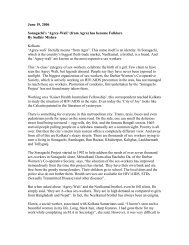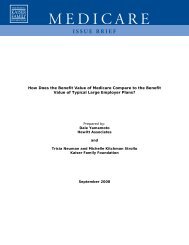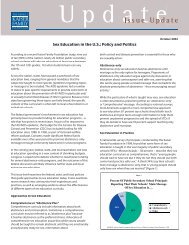TV Violence - The Henry J. Kaiser Family Foundation
TV Violence - The Henry J. Kaiser Family Foundation
TV Violence - The Henry J. Kaiser Family Foundation
You also want an ePaper? Increase the reach of your titles
YUMPU automatically turns print PDFs into web optimized ePapers that Google loves.
<strong>The</strong> <strong>Henry</strong> J. <strong>Kaiser</strong><br />
<strong>Family</strong> <strong>Foundation</strong><br />
2400 Sand Hill Road<br />
Menlo Park, CA 94025<br />
Phone: 650-854-9400<br />
Fax: 650-854-4800<br />
Washington Offi ce:<br />
1330 G Street, NW<br />
Washington, DC 20005<br />
Phone: 202-347-5270<br />
Fax: 202-347-5274<br />
www.kff.org<br />
<strong>TV</strong> <strong>Violence</strong><br />
Since the advent of television, the effect of <strong>TV</strong><br />
violence on society has been widely studied and<br />
vigorously debated. Based on the cumulative<br />
evidence of studies conducted over several decades,<br />
the scientifi c and public health communities<br />
overwhelmingly conclude that viewing violence poses<br />
a harmful risk to children. Critics of the research<br />
challenge this conclusion and dispute claims that<br />
exposure to <strong>TV</strong> violence leads to real-life aggression.<br />
As we move into the digital era with enhanced images<br />
and sound, media violence will undoubtedly continue<br />
to be a focus of public concern and scientifi c<br />
research.<br />
Prevalence of <strong>Violence</strong> on <strong>TV</strong><br />
<strong>The</strong> National Television <strong>Violence</strong> Study is the largest<br />
content analysis undertaken to date. It analyzed<br />
programming over three consecutive <strong>TV</strong> seasons<br />
from 1994 to 1997. 1 Among the fi ndings:<br />
• Nearly 2 out of 3 <strong>TV</strong> programs contained some<br />
violence, 2 averaging about 6 violent acts per hour. 3<br />
• Fewer than 5% of these programs featured an<br />
anti-violence theme or prosocial message emphasizing<br />
alternatives to or consequences of violence. 4<br />
• <strong>Violence</strong> was found to be more prevalent in children’s<br />
programming (69%) than in other types of<br />
programming (57%). In a typical hour of programming,<br />
children’s shows featured more than twice<br />
as many violent incidents (14) than other types of<br />
programming (6). 5<br />
• <strong>The</strong> average child who watches 2 hours of<br />
cartoons a day may see nearly 10,000 violent incidents<br />
each year, of which the researchers estimate<br />
that at least 500 pose a high risk for learning and<br />
imitating aggression and becoming desensitized to<br />
violence. 6<br />
• <strong>The</strong> number of prime-time programs with violence<br />
increased over the three years of the study, from<br />
53% to 67% on broadcast television and from<br />
54% to 64% on basic cable. Premium cable net-<br />
<strong>The</strong> <strong>Kaiser</strong> <strong>Family</strong> <strong>Foundation</strong> is an independent, national health philanthropy dedicated to providing<br />
information and analysis on health issues to policymakers, the media, and the general public.<br />
<strong>The</strong> <strong>Foundation</strong> is not associated with <strong>Kaiser</strong> Permanente or <strong>Kaiser</strong> Industries.<br />
Spring 2003<br />
works have the highest percentage of shows with<br />
violence, averaging 92% since 1994. 7<br />
<strong>The</strong> UCLA Television <strong>Violence</strong> Monitoring Report<br />
also analyzed three years of programming from 1994<br />
to 1997. This study relied on the qualitative judgments<br />
of a team of student monitors and staff researchers,<br />
rather than a systematic content analysis, to determine<br />
whether individual violent depictions “raised<br />
concern” for viewers. 8 Among the fi ndings:<br />
• Children’s Saturday morning <strong>TV</strong> shows that<br />
feature “sinister combat violence” raised the most<br />
serious concerns for these researchers. <strong>The</strong>se are<br />
fantasy live-action shows and animated cartoons<br />
in which violence is central to the storyline, the villains<br />
and superheroes use violence as an acceptable<br />
and effective way to get what they want, and<br />
the perpetrators are valued for their combat ability.<br />
Among the most popular shows for children, the<br />
number of troubling shows in this genre decreased<br />
from seven to four over the three years of the<br />
study. 9<br />
• <strong>The</strong> number of prime time series that raised<br />
frequent concerns about violence steadily declined<br />
over the three years, from nine such series in<br />
1994–95 to just two in 1996–97. 10<br />
• <strong>TV</strong> specials was the only category that raised new<br />
concerns at the end of the three years. In the second<br />
year fi ve live-action reality shows featured real<br />
or re-created graphic images of animals attacking<br />
and sometimes killing people. By the third year, the<br />
number of such shows had increased again. 11<br />
Scientifi c Studies of <strong>TV</strong> <strong>Violence</strong> Effects<br />
Researchers hypothesize that viewing <strong>TV</strong> violence<br />
can lead to three potentially harmful effects: increased<br />
antisocial or aggressive behavior, desensitization to<br />
violence (becoming more accepting of violence in real<br />
life and less caring about other people’s feelings),<br />
or increased fear of becoming a victim of violence. 12<br />
Many researchers believe that children age 7 and<br />
younger are particularly vulnerable to the effects of<br />
T H E H E N R Y J . K A I S E R F A M I LY F O U N D A T I O N
viewing violence because they tend to perceive fantasy<br />
and cartoon violence as realistic. 13<br />
Since the 1960s, a body of research literature has<br />
been accumulating on the effects of <strong>TV</strong> violence.<br />
Taken together, the studies conclude that <strong>TV</strong> violence<br />
is one of many factors that contribute to aggressive<br />
behavior. Following are examples of the various types<br />
of research studies that have been conducted: 14<br />
Laboratory experiments are conducted in a<br />
controlled setting in order to manipulate media<br />
exposure and assess the short-term effects.<br />
Participants are randomly assigned to view either a<br />
violent or nonviolent fi lm clip and their subsequent<br />
behavior is observed.<br />
• A series of classic experiments conducted in the<br />
1960s provided the earliest evidence of a link<br />
between <strong>TV</strong> violence and aggression. In these<br />
studies, children who were exposed to a <strong>TV</strong> clip of<br />
an actor hitting an infl atable doll were more likely<br />
than children who did not see the clip to imitate<br />
the action in their play, especially if the aggressive<br />
actions in the fi lm clip were rewarded. 15<br />
• Other laboratory experiments have indicated that<br />
exposure to media violence increases children’s<br />
tolerance for real-life aggression. For example,<br />
when third- and fourth-graders were left in charge<br />
of two younger children they could see on a <strong>TV</strong><br />
monitor, the ones who viewed an aggressive fi lm<br />
were much more reluctant than those who had<br />
not seen the fi lm to ask an adult for help when the<br />
younger children began to fi ght, even though the<br />
fi ght was becoming progressively aggressive. 16<br />
Field experiments are conducted in a more<br />
naturalistic setting. As with the laboratory studies,<br />
children are shown video clips and their short-term<br />
post-viewing behavior is monitored by researchers.<br />
Over the past 30 years, numerous fi eld studies<br />
have indicated that some children behave more<br />
aggressively after viewing violence.<br />
• In one study, researchers showed children episodes<br />
of either Batman and Spiderman or Mister<br />
Rogers’ Neighborhood over several weeks and<br />
then observed their behavior for two weeks afterwards.<br />
<strong>The</strong> children who viewed violent cartoons<br />
were more likely to interact aggressively with their<br />
peers, while those children who watched Mister<br />
Rogers’ Neighborhood became more cooperative<br />
and willing to share toys. 17<br />
• In another study, researchers exposed children to<br />
an episode of Mighty Morphin Power Rangers and<br />
then observed their verbal and physical aggression<br />
in the classroom. Compared to children who had<br />
not seen the episode, viewers committed seven<br />
times as many aggressive acts such as hitting,<br />
kicking, shoving, and insulting a peer. 18<br />
Cross-sectional studies survey a large and<br />
representative sample of viewers at one point in time.<br />
Since the 1970s, a large number of these studies<br />
have concluded that viewing <strong>TV</strong> violence is related<br />
to aggressive behavior and attitudes. 19 <strong>The</strong>se studies<br />
are correlational and do not prove causality; that is,<br />
it is diffi cult to know whether watching violence on<br />
<strong>TV</strong> is causing the increase in aggression or whether<br />
viewers who are already aggressive prefer watching<br />
violent content.<br />
• In one study, 2,300 junior and senior high school<br />
students were asked to list their four favorite<br />
programs, which were analyzed for violent content,<br />
and to provide a self-reported checklist of activities<br />
that ranged from fi ghting at school to serious<br />
delinquency. Researchers found that teens whose<br />
favorite programs were violent tended to report a<br />
higher incidence in overall aggressive and delinquent<br />
behavior. 20<br />
• A recent study demonstrated a relationship between<br />
children’s bullying and their exposure to media<br />
violence. Third-, fourth-, and fi fth-graders who<br />
were identifi ed by their peers as being the ones<br />
who spread rumors, exclude and insult peers, and<br />
behave in ways that hurt others, were more likely<br />
to view violence than nonaggressive children. 21<br />
Longitudinal studies offer the best way to study<br />
long-term effects of exposure to violent <strong>TV</strong> content.<br />
<strong>The</strong>se studies survey the same group of individuals at<br />
several different times over many years to determine<br />
whether viewing violence is related to subsequent<br />
aggressive behavior. This method is designed to<br />
detect causal relationships and statistically control for<br />
environmental, family, and personal characteristics<br />
that might otherwise account for aggression.<br />
• One study demonstrated that <strong>TV</strong> habits of children<br />
in the 1960s were a signifi cant predictor of adult<br />
aggression, even criminal behavior, regardless of<br />
children’s initial aggressiveness, IQ, social status,<br />
or parenting style. In this study, which spans more<br />
than 20 years, boys who preferred and viewed<br />
more violent programming at age 8 were more<br />
likely to be aggressive as teenagers and have<br />
arrests and convictions as adults for interpersonal<br />
crimes such as spousal and child abuse, murder,<br />
and aggravated assault. 22<br />
• Television exposure during adolescence has also<br />
been linked to subsequent aggression in young<br />
adulthood. A 17-year longitudinal study concluded<br />
that teens who watched more than one hour of<br />
<strong>TV</strong> a day were almost four times as likely as other<br />
teens to commit aggressive acts in adulthood<br />
(22% versus 6%), taking into account prior aggressiveness,<br />
psychiatric disorders, family income,<br />
parental education, childhood neglect, and neighborhood<br />
violence. 23<br />
Key Facts: <strong>TV</strong> <strong>Violence</strong> Spring 2003 Page 2
Meta-analyses use a statistical procedure to<br />
combine the results from many different studies.<br />
• <strong>The</strong> largest meta-analysis on <strong>TV</strong> violence analyzed<br />
217 studies conducted between 1957 and 1990,<br />
and found that viewing violence was signifi cantly<br />
linked to aggressive and antisocial behavior, especially<br />
among the youngest viewers. <strong>The</strong> overall<br />
effect size was .31, meaning that exposure to <strong>TV</strong><br />
violence was estimated to account for 10% of the<br />
variance in antisocial behavior. 24<br />
Opposing Viewpoint<br />
A small number of critics of the scientifi c evidence<br />
have concluded that <strong>TV</strong> violence does not contribute<br />
to real-life aggression. For the most part, they do<br />
not base their conclusions on studies with contrary<br />
fi ndings, but argue that the studies that have been<br />
conducted are fl awed. 25<br />
• One of the leading critics challenges the notion<br />
that young children cannot distinguish between fi ction<br />
and reality. He agrees that children may learn<br />
from what they see, but contends that the main<br />
messages they see are that good will prevail over<br />
evil, and that it is the evil forces who are fi rst to<br />
use violence. 26<br />
• One group of researchers conducted two largescale<br />
longitudinal studies over a three-year period<br />
in the 1980s. <strong>The</strong>y concluded that the results did<br />
not meet their established criteria for detecting a<br />
documented effect of media violence on behavior.<br />
27<br />
• Over the years, some researchers have hypothesized<br />
that watching violence on television should<br />
reduce angry feelings and aggressive actions in<br />
real life. Several studies have attempted to prove<br />
this relationship, known as the “catharsis hypothesis,”<br />
but the evidence has not been supportive. 28<br />
• <strong>The</strong> method used to study media violence has<br />
been a main target of criticism. For example,<br />
experimental studies have been criticized for their<br />
artifi cial viewing situations, unrealistic measures<br />
of aggression, and short-term effects. Correlational<br />
studies have been dismissed for not proving<br />
causation, and longitudinal studies have been criticized<br />
for not demonstrating strong or consistent<br />
results. 29<br />
Conclusions Drawn by the Public Health<br />
Community<br />
Over the years, major medical and public health<br />
organizations have reviewed the research and the<br />
critiques, and made their own assessments of the<br />
evidence.<br />
National Commission on the Causes and<br />
Prevention of <strong>Violence</strong>. In a 1969 report, the<br />
Commission stated: “<strong>Violence</strong> on television<br />
encourages violent forms of behavior. . . We do not<br />
suggest that television is a principal cause of violence<br />
in society. We do suggest that it is a contributing<br />
factor.” 30<br />
Surgeon General’s Scientifi c Advisory Committee<br />
on Television and Social Behavior. In 1972, the<br />
Committee commissioned a fi ve-volume set of<br />
research on <strong>TV</strong>’s impact on children. <strong>The</strong>y concluded<br />
that the evidence supports “a preliminary and<br />
tentative indication of a causal relation between<br />
viewing violence on television and aggressive<br />
behavior” for “some children [who are predisposed to<br />
be aggressive]. . . in some environmental contexts.” 31<br />
National Institute of Mental Health. In 1982, the<br />
Institute concluded: “<strong>The</strong> consensus among most of<br />
the research community is that violence on television<br />
does lead to aggressive behavior by children and<br />
teenagers. . . Not all children become aggressive,<br />
of course, but the correlations between violence<br />
and aggression are positive. In magnitude, television<br />
violence is as strongly correlated with aggressive<br />
behavior as any other behavioral variable that has<br />
been measured.” 32<br />
American Psychological Association. In 1993, the<br />
APA Committee on Media and Society concluded:<br />
“<strong>The</strong>re is absolutely no doubt that higher levels of<br />
viewing violence on television are correlated with<br />
increased acceptance of aggressive attitudes and<br />
increased aggressive behavior.” 33<br />
Joint Statement of the Public Health Community.<br />
In July 2000, the American Academy of Pediatrics,<br />
American Academy of Child & Adolescent Psychiatry,<br />
American Psychological Association, American<br />
Medical Association, American Academy of <strong>Family</strong><br />
Physicians, and American Psychiatric Association<br />
issued a joint statement that concluded: “At this<br />
time, well over 1,000 studies point overwhelmingly<br />
to a causal connection between media violence and<br />
aggressive behavior in some children. . .” 34<br />
Youth <strong>Violence</strong>: A Report of the Surgeon General.<br />
In 2001, the Surgeon General’s report on youth<br />
violence concluded that “media violence increases<br />
children’s physically and verbally aggressive behavior<br />
in the short term,” but also noted that “the causal<br />
links. . .are more fi rmly established for aggressive<br />
. . .than for violent behavior.” 35<br />
1 Center for Communication and Social Policy, University<br />
of California, Santa Barbara (UCSB), National Television<br />
<strong>Violence</strong> Study, Executive Summary, Volume 3, 1998.<br />
Commissioned by the National Cable Television Association,<br />
the study analyzed almost 10,000 hours of broadcast and<br />
cable programming randomly selected from 23 channels<br />
over the course of three <strong>TV</strong> seasons from 1994 to 1997.<br />
2 Ibid., 30. Researchers defi ned three main types of violent<br />
depictions: credible threats, behavioral acts, and harmful<br />
consequences.<br />
3 Ibid., 33.<br />
4 Ibid.<br />
Key Facts: <strong>TV</strong> <strong>Violence</strong> Spring 2003 Page 3
5 Barbara Wilson et al., “<strong>Violence</strong> in Children’s Television<br />
Programming: Assessing the Risks,” Journal of<br />
Communication 52 (2002): 5–35.<br />
6 Center for Communication and Social Policy, UCSB,<br />
33–34.<br />
7 Ibid., 32.<br />
8 UCLA Center for Communication Policy, UCLA Television<br />
<strong>Violence</strong> Monitoring Report, 1998, (28 September 2002).<br />
Commissioned by the National Association of Broadcasters,<br />
the researchers analyzed more than 3,000 hours of <strong>TV</strong><br />
over three consecutive <strong>TV</strong> seasons from 1994 to 1997.<br />
<strong>TV</strong> shows with violence were divided into four different<br />
categories based on the level of concern, ranging from high<br />
levels of violence and serious concern to no serious concern<br />
because the context is appropriate.<br />
9 Ibid., <br />
(28 September 2002).<br />
10 Ibid., <br />
(28 September 2002).<br />
11 Ibid., (28 September 2002).<br />
12 American Psychological Association, Report of the<br />
American Psychological Association Commission on<br />
<strong>Violence</strong> and Youth, Volume 1, 1993, 33; Stacy L. Smith and<br />
Edward Donnerstein, “Harmful Effects of Exposure to Media<br />
<strong>Violence</strong>: Learning of Aggression, Emotional Desensitization,<br />
and Fear,” Human Aggression: <strong>The</strong>ories, Research,<br />
and Implications for Social Policy, eds. R. Geen and E.<br />
Donnerstein (New York: Academic Press, 1998), 167–202.<br />
13 Brad Bushman and L. Rowell Huesmann, “Effects of<br />
Televised <strong>Violence</strong> on Aggression,” Handbook of Children<br />
and the Media, eds. D. Singer and J. Singer (Thousand<br />
Oaks, CA: Sage Publications, 2001), 223–268.<br />
14 For summaries of these studies, see Bushman and<br />
Huesmann, 2001; Victor Strasburger and Barbara Wilson,<br />
”Media <strong>Violence</strong>,” Children, Adolescents & the Media<br />
(Thousand Oaks, CA: Sage Publications, 2002), 73–116;<br />
W. James Potter, On Media <strong>Violence</strong> (Thousand Oaks, CA:<br />
Sage, 1999).<br />
15 Albert Bandura, Dorothea Ross, and Sheila Ross,<br />
“Transmission of Aggression through Imitation of Aggressive<br />
Models,” Journal of Abnormal and Social Psychology<br />
63 (1961): 575–582; Albert Bandura, Dorothea Ross,<br />
and Sheila Ross, “Imitation of Film-Mediated Aggressive<br />
Models,” Journal of Abnormal and Social Psyhcology 66<br />
(1963) 3–11; Albert Bandura, Dorothea Ross, and Sheila<br />
Ross, “Vicarious Reinforcement and Imitative Learning,”<br />
Journal of Abnormal and Social Psychology 67 (1963)<br />
601–607.<br />
16 Ronald S. Drabman and Margaret Hanratty Thomas,<br />
“Does Media <strong>Violence</strong> Increase Children’s Toleration of<br />
Real-Life Aggression?” Developmental Psychology 10<br />
(1974): 418–421; Ronald S. Drabman and Margaret<br />
Hanratty Thomas, “Does Watching <strong>Violence</strong> on Television<br />
Cause Apathy?” Pediatrics 57 (1976): 329–331.<br />
17 Aletha Huston-Stein and L.K. Friedrich, “Television<br />
Content and Young Children’s Social Behavior,” Television<br />
and Social Behavior, Volume II, Television and Social<br />
Learning, eds. J. Murray, E. Rubinstein, and G. Comstock<br />
(Washington, D.C.: U.S. Government Printing Offi ce, 1972),<br />
207–317.<br />
18 Chris J. Boyatzis, Gina M. Matillo, and Kristen M.<br />
Nesbitt, “Effects of the ‘Mighty Morphin Power Rangers’ on<br />
Children’s Aggression with Peers,” Child Study Journal 25:<br />
1 (1995): 45–55.<br />
19 See, for example, Bushman and Huesmann, 2001;<br />
Strasburger and Wilson, 2002; Potter, 1999.<br />
20 Jennie McIntyre and James Teevan Jr., “Television <strong>Violence</strong><br />
and Deviant Behavior,” Television and Social Behavior,<br />
Volume III, Television and Adolescent Aggressiveness, eds.<br />
G. Comstock and E. Rubinstein (Washington, D.C.: U.S.<br />
Government Printing Offi ce, 1972), 383–435.<br />
21 Audrey Buchanan et al., “What Goes in Must Come<br />
Out: Children’s Media <strong>Violence</strong> Consumption at Home and<br />
Aggressiveness at School,” (28 September 2002).<br />
22 L. Rowell Huesmann et al., “Stability of Aggression Over<br />
Time and Generations,” Developmental Psychology 20<br />
(1984): 1120–1134. This study was begun in 1960 with<br />
a sample of 875 youths in New York state; ten years later<br />
427 were re-interviewed, and twelve years later 409 were<br />
interviewed and criminal justice data was collected on 632<br />
of the original subjects.<br />
23 Jeffrey Johnson et al., “Television Viewing and Aggressive<br />
Behavior During Adolescence and Adulthood,” Science 295<br />
(March 29, 2002): 2468–2471. <strong>The</strong> longitudinal study was<br />
conducted over a 17-year time span with a sample of 707<br />
families. Criminal arrest and charge data (assault or physical<br />
fi ghts resulting in injury, robbery, threats to injure someone,<br />
or weapon used to commit a crime) were obtained.<br />
24 Haejung Paik and George Comstock, “<strong>The</strong> Effects of<br />
Television <strong>Violence</strong> on Antisocial Behavior: A Meta-Analysis,”<br />
Communication Research 21:4 (August 1994): 516–546.<br />
25 See, for example, Jonathan Freedman, Media <strong>Violence</strong><br />
and Its Effect on Aggression (Toronto: University of Toronto<br />
Press, 2002); this review was commissioned by the Motion<br />
Picture Association of America. See also Jib Fowles, <strong>The</strong><br />
Case for Television <strong>Violence</strong> (Newbury Park, CA: Sage<br />
Publications, 1999).<br />
26 Freedman, 2002, 1996.<br />
27 J. Ronald Milavsky et al., Television and Aggression:<br />
A Panel Study (New York: Academic Press, 1982). This<br />
research was undertaken by NBC’s Department of Social<br />
Research. A summary of this study was published in<br />
National Institute of Mental Health, Television and Behavior:<br />
Ten Years of Scientifi c Progress and Implications for the<br />
Eighties, Volume 2, Technical Reviews , eds. D. Pearl, L.<br />
Bouthilet, and J. Lazar (Washington, D.C.: U.S. Government<br />
Printing Offi ce, 1982), 138–157. Other researchers have<br />
since reviewed these results and interpreted them differently,<br />
concluding that the relationships were weak but not<br />
inconsistent with other studies of long-term effects. See for<br />
example, Thomas Cook et al., “<strong>The</strong> Implicit Assumptions of<br />
Television Research: An Analysis of the 1982 NIMH Report<br />
on Television and Behavior,” Public Opinion Quarterly 47:2<br />
(1983): 161-207.<br />
28 Bushman and Huesmann, 2001, 240.<br />
29 Freedman, 2002; Fowles, 1999.<br />
30 National Commission on the Causes and Prevention of<br />
<strong>Violence</strong>, Mass Media and <strong>Violence</strong> (Washington, D.C.:<br />
U.S. Government Printing Offi ce, 1969).<br />
31 Surgeon General’s Scientifi c Advisory Committee on<br />
Television and Social Behavior, Television and Growing Up:<br />
<strong>The</strong> Impact of Televised <strong>Violence</strong> (Washington, D.C.: U.S.<br />
Government Printing Offi ce, 1972), 11.<br />
32 National Institute of Mental Health, Television and<br />
Behavior: Ten Years of Scientifi c Progress and Implications<br />
for the Eighties, Volume 1, Summary Report (Washington,<br />
D.C.: U.S. Government Printing Offi ce, 1982), 6.<br />
33 American Psychological Association, <strong>Violence</strong> &<br />
Youth. Report of the American Psychological Association<br />
Commission on <strong>Violence</strong> and Youth, Volume I, 1993, 33.<br />
34 Congressional Public Health Summit, Joint Statement<br />
on the Impact of Entertainment <strong>Violence</strong> on Children,<br />
July 26, 2000, (28 September 2002).<br />
35 U.S. Surgeon General, “<strong>Violence</strong> in the Media and Its<br />
Effect on Youth <strong>Violence</strong>,” Youth <strong>Violence</strong>: A Report of the<br />
Surgeon General, Appendix 4-B (Washington, D.C.: U.S.<br />
Department of Health and Human Services, 2001), (28 September 2002).<br />
Additional copies of this publication (#3335) are<br />
available on the <strong>Kaiser</strong> <strong>Family</strong> <strong>Foundation</strong>’s website<br />
at www.kff.org.<br />
Key Facts: <strong>TV</strong> <strong>Violence</strong> Spring 2003 Page 4












